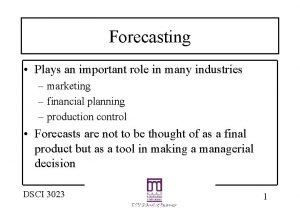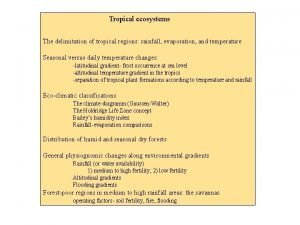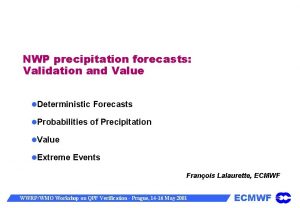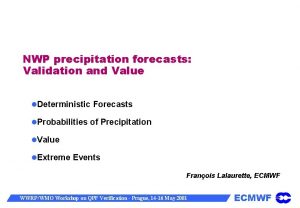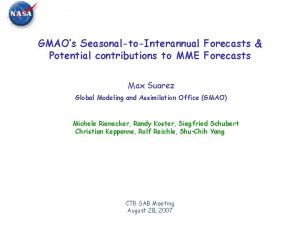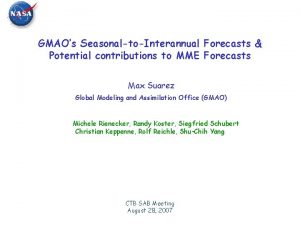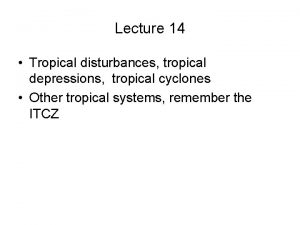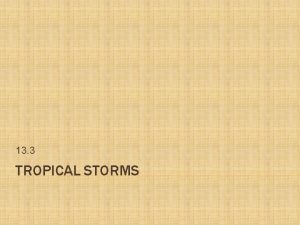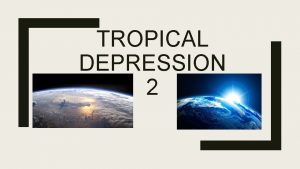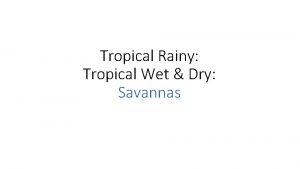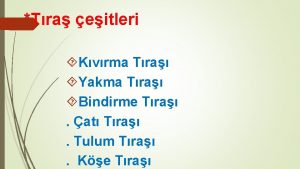Validation of Tropical Rainfall Potential TRa P Forecasts















- Slides: 15

Validation of Tropical Rainfall Potential (TRa. P) Forecasts for Typhoons In Taiwan Area Maxine Mei-Hsin Chen/ Ben Jong-Dao Jou National Science and Technology Center for Disaster Reduction / Department of Atmospheric Sciences, National Taiwan University

Validation u u What: Typhoon Rainfall Forecast field: TRa. P (satellite forecasted rainfall) Observation field: QPEsums (Radar-gauge estimated rainfall) Where: Taiwan The aim of this study is to validate TRa. P forecasts for typhoons in the Taiwan region during the 2004 -2005 season with QPEsums.

Forecast TRa. P (Tropical Rainfall Potential) u TRa. P are generated by taking instantaneous rainfall estimates from passive microwave sensor, advecting this rainfall pattern along the predicted storm track. Assumptions The satellite-estimated rain rates are correct. u The forecast storm track is correct. u The spatial pattern of rain rates relative to the storm center does not change in either coverage or magnitude, and thus moves with the storm center along the forecast track. u http: //www. ssd. noaa. gov/PS/TROP/trap-img. html

QPESUMS Surface and upper observation Lightning Rain gauge Real Time Rainfall Estimation Quantitative QPE-SUMS Precipitation ▲Radar Data Quality Control Estimation and ▲Bright Band Identification ▲Reflectivity Mosaic Segregation ▲Convective/Stratiform Identification Using ▲Hybrid Scan Mosaic Multiple Sensors Satellite Radar http: //www. nssl. noaa. gov/western/qpe/ Observation Single radar product Multiple radar product Estimated rainfall product

There are 4 Doppler Radars, and about 400 rain gauges in Taiwan. There are overlap areas between two radar observations. QPEsums select the lowest angle of elevation which doesn’t be blocked. QPEsums use Z-R relation to transform radar reflectivity to rain rate, and correct it with rain gauge observation.

What’s the special of Taiwan? 台灣地形 100 m In average, there are 3. 6 typhoons touched down in Taiwan every year. The highest mountain in Taiwan is almost 4000 m, this may cause heavy rain in mountain area when typhoon approach, especially the windward side.

Typhoon cases Typhoons approached Taiwan in the year of 2004 and 2005, and stayed in QPEsums area longer than 12 hours are chosen for validation.

Validation Result Best Forecast mm/6 hrs

In general, TRa. P underestimated rainfall the time, and dislocated the maximum rainfall. TRa. P predicted about 65� of observed rainfall, but the average correlation coefficient is only 0. 22. This may cause by the terrain enhancement and nonvarying rain pattern of TRa. P assumption.

TRa. P performed noticeably better when typhoon track across central Taiwan directly from east to west. 2

The SSM/I-based TRa. P products performed much better than other sensor-based TRa. P products at Taiwan cases.

Contiguous Rain Area (CRA) error decomposition This method fellow Ebert et al. (2004) Volume Pattern Displacement error NOCKTEN AERE 25 % 45 % 30 % 35 % 50 % 15 % Error decomposition of the TRa. P for regions of heavy rain shows pattern errors accounted for about half of the total error. These errors are possibly related to the satellite rain rate retrieval as well as the assumption of a nonvarying rain pattern, and particularly the effect of interaction between rainbands and topography in Taiwan.

HAITANG TALIM There is a strong relation between heavy rain area and typhoon center, because of Taiwan topography. AERE NOCK-TEN

Comparison of validation in different country

The End Thank you
 As compared to long-range forecasts, short-range forecasts
As compared to long-range forecasts, short-range forecasts Deciduous forest rainfall per year
Deciduous forest rainfall per year Forecasting plays an important role in
Forecasting plays an important role in Compare and contrast analog and digital forecasts
Compare and contrast analog and digital forecasts Weather forecast lesson 3 outline answers
Weather forecast lesson 3 outline answers Graded potential vs action potential
Graded potential vs action potential Potential and potential difference
Potential and potential difference Succinylcholine dose
Succinylcholine dose Neuronal pool
Neuronal pool Define electric potential and potential difference.
Define electric potential and potential difference. Absolute refractory period
Absolute refractory period Potential energy of an electric field
Potential energy of an electric field Flaccid cell
Flaccid cell Action potential resting potential
Action potential resting potential Graded potential and action potential
Graded potential and action potential Electric potential and potential energy
Electric potential and potential energy


